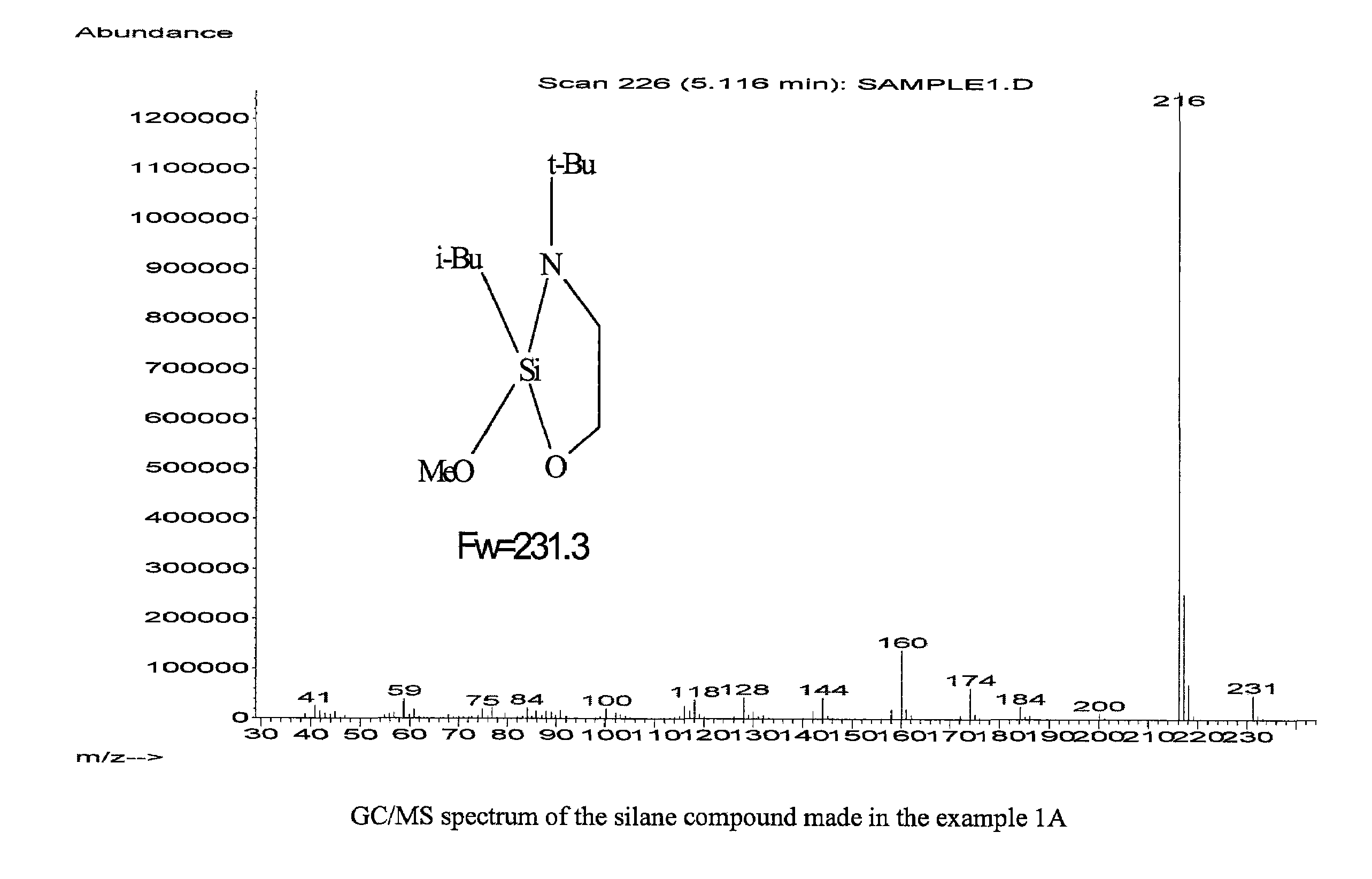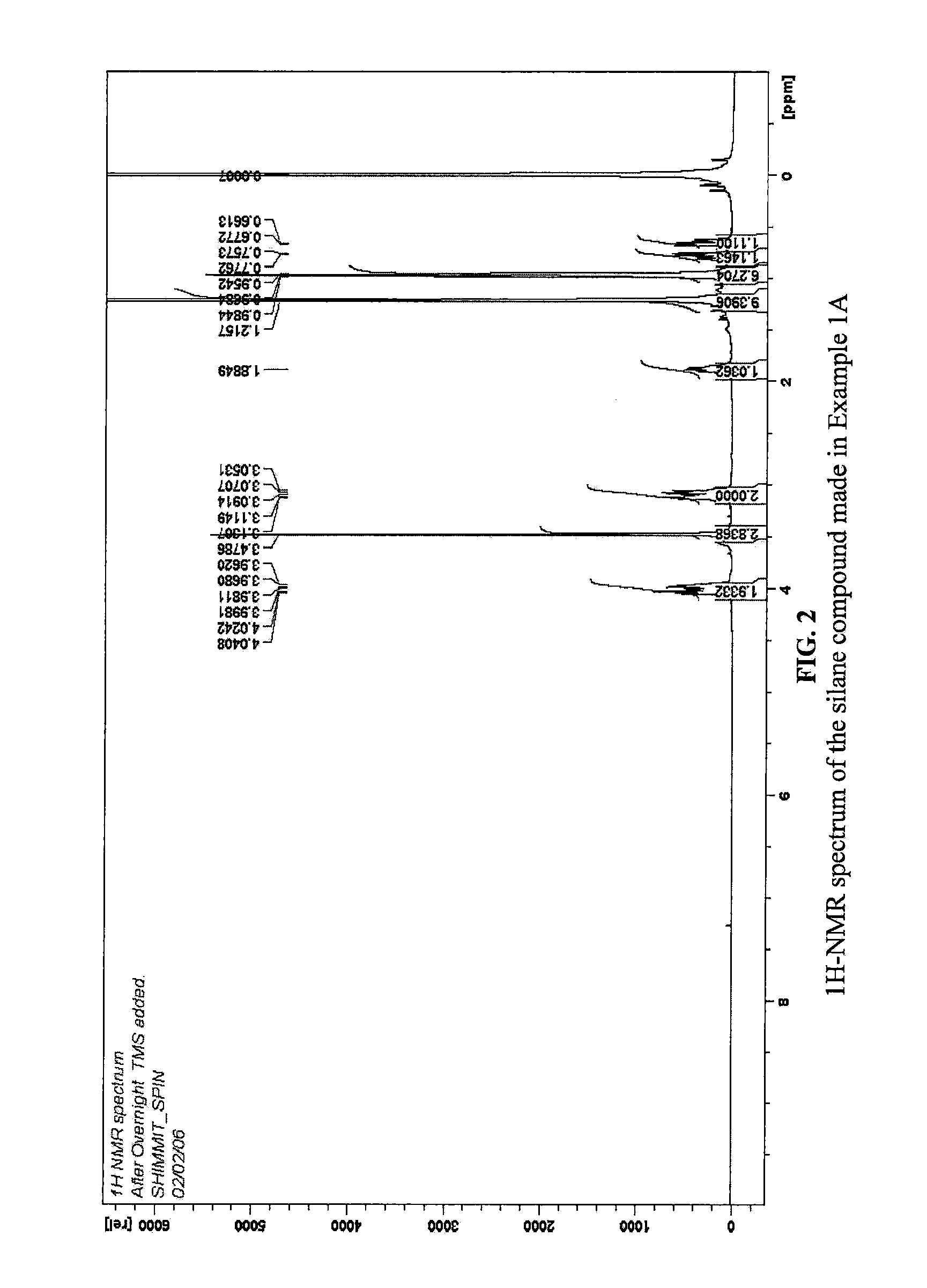Cyclic organosilicon compounds as electron donors for polyolefin catalysts
a polyolefin catalyst and electron donor technology, applied in the field of cyclic organosilicon compounds, can solve the problems of difficult control of polymer structure and product quality, complicated disclosure operations, and low production efficiency, and achieve the effect of broadening the molecular weight distribution
- Summary
- Abstract
- Description
- Claims
- Application Information
AI Technical Summary
Benefits of technology
Problems solved by technology
Method used
Image
Examples
example 1a
[0075]This example illustrates an organosilicon compound in accordance with the present invention and a method of preparing the same.
(a) Preparation of 3-tert-Butyl-2 chloro-2-isobutyl-[1,3,2]oxazasilolidine
[0076]2-(tert-Butylamino)ethanol (0.125 mmol, 99%, from Aldrich) was dissolved in THF (100 ml, anhydrous, from Aldrich) in a 250 ml flask with a ice-water bath, and while stirring n-butyllithium (100 ml of a 2.5 M solution in hexanes, from Aldrich) was added dropwise over a period of 40 minutes. Then, the ice-water bath was removed and the reaction mixture was stirred for 20 minutes at room temperature. A pale yellow clear solution was obtained.
[0077]While stirring, the obtained solution was added dropwise into a 500 ml flask containing 0.125 mol isobutyltrichlorosilane (from Gelest) and 250 ml Heptane cooled by an ice-water bath. The resultant reaction mixture was stirred for 30 minutes and thereafter the ice-water bath was removed and the reaction was carried on at room tempera...
example 1b
[0079]This example illustrates another method of preparing 3-tert-Butyl-2-isobutyl-2methoxy-[1,3,2]oxazasilolidine.
Preparation of 3-tert-Butyl-2-isobutyl-2methoxy-[1,3,2]oxazasilolidine
[0080]2-(tert-Butylamino)ethanol (0.08 mol, 99%, from Aldrich) was dissolved in THF (100 ml, anhydrous, from Aldrich) in a 250 ml flask with an ice-water bath, and while stirring n-butyllithium (100 ml of a 1.6 M solution in hexanes, from Aldrich) was added dropwise over a period of about 30 minutes. Then, the ice-water bath was removed and stirring of the reaction mixture was maintained for 20 minutes at room temperature.
[0081]The above prepared reaction mixture was added into a 500 ml flask containing a stirring mixture of 14.3 g isobutyltrimethoxysilane (from Gelest), 120 ml heptane and 120 ml THF over a period of 15 minutes at room temperature. Thereafter, the reaction temperature was raised to 60° C. with an oil-bath. The reaction was carried out at 60° C. for 5 hours with stirring. Stir was stop...
examples 2 to 8
[0082]The procedure and ingredients of Example 1A were repeated except that isobutyltrichlorosilane was replaced by the chemicals (RSiCl3) shown in Table 1.
[0083]
TABLE 1ExampleRSiCl3Final Product2Isooctyltrichlorosilane3-tert-Butyl-2-methoxy-2-(2,4,4-trimethyl-pentyl)-[1,3,2]oxazasilolidine3t-Butyltrichlorosilane2,3-Di-tert-butyl-2-methoxyl-[1,3,2]oxazasilolidine4Cyclopentyltrichlorosilane3-tert-Butyl-2-cyclopentyl-2-methoxy-[1,3,2]oxazasilolidine5Cyclohexyltrichlorosilane3-tert-Butyl-2-cyclohexyl-2-methoxy-[1,3,2]oxazasilolidine65-2-Bicyclo[2.2.1]hept-5-(Bicycloheptenyl)trichlorosilaneen-2-yl-3-tert-butyl-2-methoxy-[1,3,2]oxazasilolidine7Phenyltrichlorosilane3-tert-Butyl-2-methoxy-2-phenyl-[1,3,2]oxazasilolidine
PUM
| Property | Measurement | Unit |
|---|---|---|
| molar ratio | aaaaa | aaaaa |
| molar ratio | aaaaa | aaaaa |
| temperatures | aaaaa | aaaaa |
Abstract
Description
Claims
Application Information
 Login to View More
Login to View More - R&D
- Intellectual Property
- Life Sciences
- Materials
- Tech Scout
- Unparalleled Data Quality
- Higher Quality Content
- 60% Fewer Hallucinations
Browse by: Latest US Patents, China's latest patents, Technical Efficacy Thesaurus, Application Domain, Technology Topic, Popular Technical Reports.
© 2025 PatSnap. All rights reserved.Legal|Privacy policy|Modern Slavery Act Transparency Statement|Sitemap|About US| Contact US: help@patsnap.com



